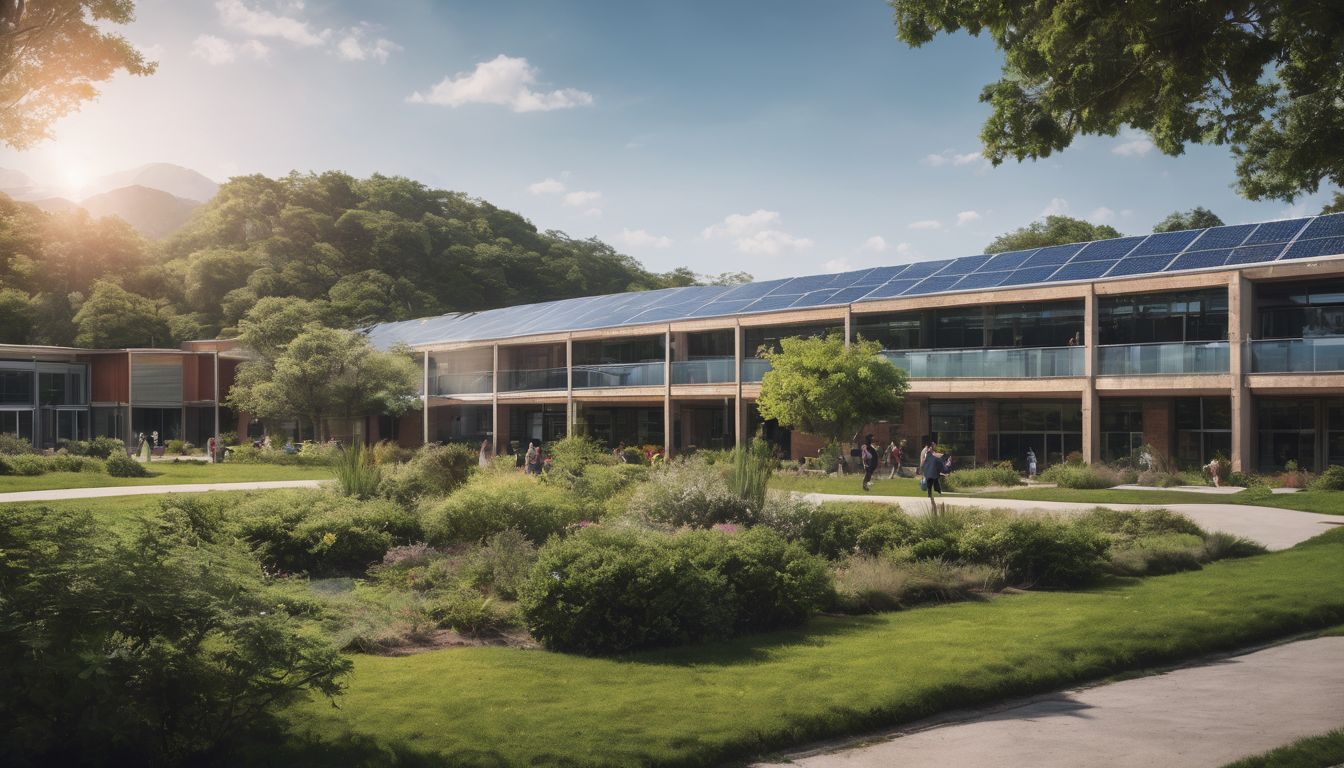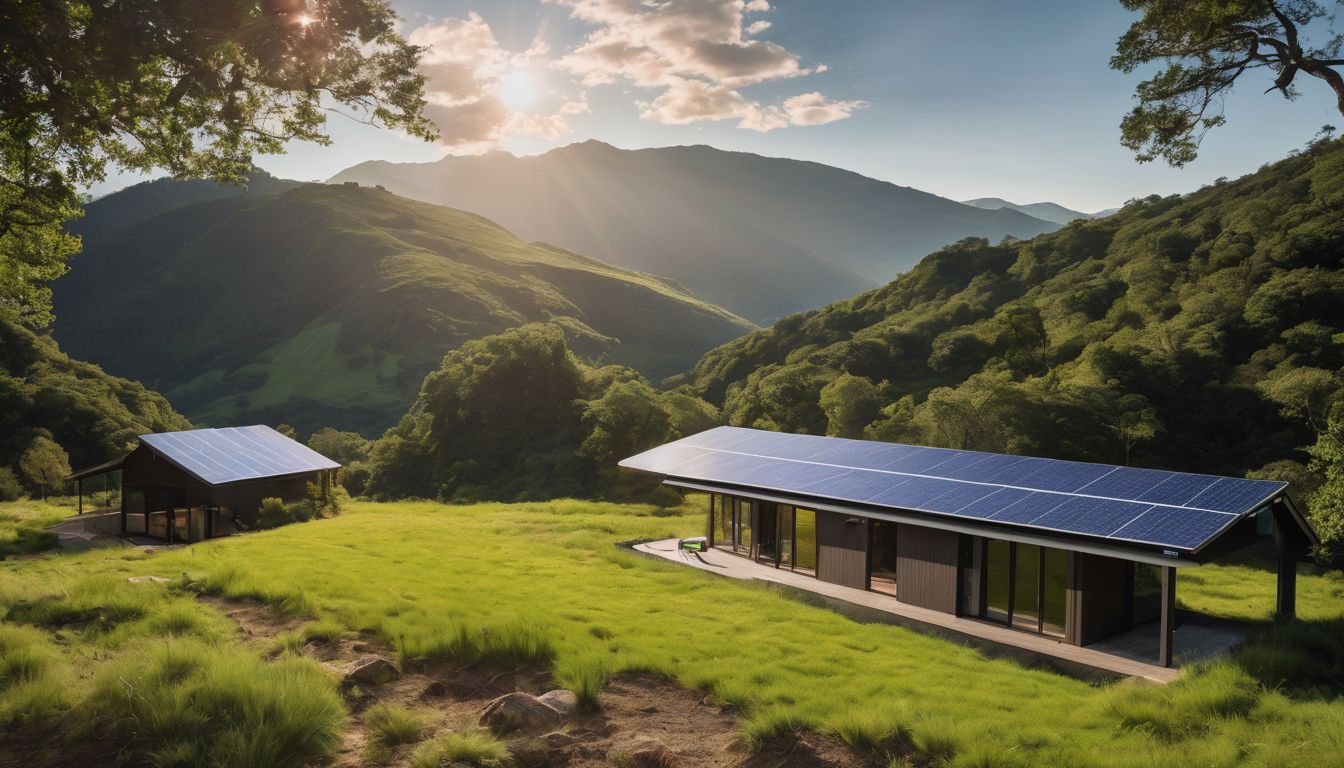In these times, we’re all trying to be kinder to our planet. Did you know schools are now using cool tech to teach us about being green? This article will show you how gadgets and games can make learning about the environment super fun.
Let’s dig in and grow our green knowledge!
Key Takeaways
- Technology enhances green education by offering interactive experiences like virtual tours and educational apps, allowing students to explore distant ecosystems and sustainable practices without leaving the classroom.
- Hands – on learning tools such as solar toys, wind turbines, and renewable energy kits directly involve students in understanding and applying principles of sustainability and conservation.
- By integrating technology into environmental education, schools promote eco – friendly behaviours among students, preparing them for a future that values green technologies in the job market.
- Outdoor learning spaces complemented by digital resources encourage real-world problem-solving and a personal connection with nature while promoting physical well-being.
- Higher education institutions contribute significantly to advancing green technologies through research, development of sustainable solutions, and equipping graduates with skills for the growing eco-friendly economy.
Bridging the Gap: Integrating Technology and Environmental Education
Addressing nature deficit and bridging the digital divide are crucial aspects of integrating technology into environmental education. By using technology effectively, we can enhance the learning experience and engage students in sustainable practices.
Addressing nature deficit
Kids today spend less time outdoors, leading to a nature deficit that affects their understanding and appreciation of the environment around them. Technology offers solutions by creating interactive experiences that connect children with nature even when they can’t be outside.
For example, apps that simulate garden building or wildlife tracking encourage young minds to explore ecological concepts from their own homes.
Teachers can flip this deficit into an opportunity for environmental stewardship by integrating tech-based learning in the curriculum. Virtual field trips bring the wonders of rainforests or coral reefs right into the classroom, sparking curiosity and concern for these ecosystems.
Renewable energy kits enable hands-on activities demonstrating how solar panels and wind turbines work, linking theory with tangible examples and helping students grasp sustainable technology’s pivotal role in conservation efforts.
Bridging the digital divide
To bridge the digital divide in environmental education, providing access to technology is crucial. This involves ensuring that all students have equal opportunities to engage with digital learning resources and tools.
By addressing this gap, we can empower students from diverse backgrounds to participate in green education initiatives and develop a better understanding of environmental sustainability.
Additionally, offering access to technology can facilitate the acquisition of essential digital skills that are increasingly important in today’s green economy.
Integrating technology into environmental education not only enhances learning experiences but also cultivates a generation of environmentally conscious individuals who are equipped with the necessary skills to contribute positively towards conservation efforts and sustainable solutions.
Using technology effectively in environmental education
Educational apps facilitate interactive learning, fostering understanding of eco-friendly practices and green innovation. Virtual tours offer immersive experiences, promoting environmental conservation and problem-solving activities.
Solar toys engage students in hands-on learning about renewable energy, while wind turbines demonstrate sustainable solutions in action.
E-learning tools enhance access to environmental education, empowering students to embrace green technologies for a more sustainable future. Electric vehicles showcase practical applications of green innovation, inspiring the next generation of environmentally conscious individuals to champion eco-friendly practices and outdoor learning spaces.
Implementing technology effectively in environmental education bridges the gap between traditional teaching methods and innovative solutions for a greener tomorrow.
Tools for Teachers: Technology for Environmental Education
Educational apps, virtual tours, and hands-on experiments with solar toys and wind turbines are just some of the tools that teachers can use to integrate technology into environmental education.
These resources provide engaging and interactive learning experiences for students, allowing them to explore and understand green technologies in a practical way.
Educational apps
With educational apps, students can engage in interactive learning experiences. They can explore topics such as renewable energy, conservation, and sustainable living with ease using these apps. The educational apps provide real-life scenarios, problem-solving activities, and simulations to help students understand the impact of their actions on the environment. Additionally, they offer virtual field trips to various ecological sites around the world, allowing students to experience different ecosystems firsthand. These apps also incorporate gamification elements that make learning about environmental issues enjoyable and engaging. Furthermore, they help students develop a sense of responsibility towards the environment by empowering them with knowledge and practical solutions to address ecological challenges.
Virtual tours
Continuing the exploration of technology for environmental education, virtual tours offer immersive experiences that bring learning to life. This interactive tool allows students to explore ecosystems, visit conservation sites, and witness the impact of human activities on the environment in a realistic and engaging manner.
- Engaging Exploration: Virtual tours provide a captivating way for students to visit remote locations, such as rainforests, coral reefs, or national parks, without leaving the classroom.
- Real-world Applications: By virtually visiting sustainable energy facilities or eco-friendly buildings, students can gain insight into practical applications of green technology and its impact on conservation efforts.
- Multi-sensory Learning: Through 360-degree videos and interactive features, virtual tours stimulate visual and auditory senses while conveying environmental concepts effectively.
- Global Perspective: Virtual tours offer opportunities for students to broaden their understanding of diverse ecosystems and sustainable practices across the globe, fostering a sense of global citizenship in environmental conservation.
- Interactive Learning Tools: Educators can integrate quizzes, discussion prompts, and supplemental resources within virtual tours to promote active participation and reinforce learning objectives related to eco-friendly practices and green technology.
- Empowering Experiences: Virtual tours empower students by allowing them to take ownership of their learning experiences while developing a deeper connection with nature and sustainable living practices.
Solar toys and experiments
Solar toys and experiments offer engaging ways to teach about renewable energy. Students can learn the principles of solar power through hands-on activities and problem-solving exercises.
- Building solar – powered model cars teaches about harnessing sunlight for energy in a fun, interactive way.
- Conducting experiments with solar ovens demonstrates how sunlight can be used for cooking and heating.
- Creating solar – powered gadgets, such as mini fans or chargers, allows students to see the practical applications of solar energy in everyday life.
- Exploring the concept of solar cells through building simple circuits helps students understand the science behind solar power.
Wind turbines
Wind turbines harness the power of the wind to generate electricity. They are a crucial component of green education, demonstrating renewable energy in action. By incorporating wind turbines into environmental education, students can learn about sustainable energy sources and engage in hands-on learning experiences.
Wind turbines also serve as a visual reminder of the potential for eco-friendly practices and problem-solving activities. Integrating wind turbines into educational settings can help inspire environmentally conscious individuals while promoting eco-friendly education.
Furthermore, exploring the workings of wind turbines through e-learning tools or virtual tours can provide an interactive understanding of how they contribute to sustainable solutions.
Higher Education’s Contribution to Green Technologies
Higher education plays a vital role in advancing green technologies through research and development, promoting sustainable solutions, and preparing students for the growing green job market.
These contributions are essential for addressing environmental challenges and creating a more sustainable future.
Research and development
Green education is being furthered through research and development into sustainable solutions. Institutions are investing in innovative technologies such as solar energy, wind turbines, and other eco-friendly practices to reduce their carbon footprint.
These advancements not only promote sustainability but also prepare students for the growing job market in green technologies.
Universities and colleges play a crucial role in developing new green technologies that will benefit both the environment and society. By supporting research initiatives focused on eco-friendly practices, higher education institutions contribute to finding practical solutions for environmental challenges.
Promoting sustainable solutions
Technology plays a vital role in promoting sustainable solutions within green education. It helps to develop innovative methods for solving environmental challenges, fostering eco-friendly practices and encouraging problem-solving activities.
By incorporating e-learning tools and eco-friendly educational apps, students are empowered to engage with sustainable solutions actively.
Moreover, technology enables the implementation of outdoor learning spaces and hands-on experiences that promote environmental conservation and awareness. This engagement fosters behaviours that support sustainability in future generations.
Additionally, it prepares students for the evolving green job market by instilling practical knowledge and skills needed for creating a more sustainable world.
Preparing students for the green job market
Schools must equip students with the knowledge and skills necessary to thrive in the growing green job market. Educators play a critical role in preparing future professionals through hands-on experiences, internships, and industry partnerships.
By integrating eco-friendly practices and problem-solving activities into the curriculum, schools can foster a generation of environmentally conscious individuals ready to contribute to sustainable solutions.
Graduates should be equipped with e-learning resources and practical experience that promote conservation and environmental stewardship, ensuring they are well-prepared for careers in green technologies.
Green Technology in Schools: Eco-friendly Practices and Sustainable Solutions
Implementing eco-friendly practices in schools, such as waste reduction and energy conservation, is essential for creating a sustainable learning environment. Additionally, creating outdoor learning spaces and promoting outdoor education can further enhance students’ connection to the natural world.
Creating outdoor learning spaces
Creating outdoor learning spaces is a powerful way to engage students in environmental education. It offers hands-on experiences and fosters a deeper connection with nature.
- Designing natural habitats: Transforming areas within the school grounds into native plant gardens, wildlife habitats, or sustainable landscapes creates opportunities for students to experience and learn about local ecosystems.
- Building outdoor classrooms: Constructing shaded areas with seating, whiteboards, and natural elements such as rocks and logs provides an inspiring setting for outdoor lessons and discussions on environmental topics.
- Establishing community gardens: Allotting spaces for gardening activities not only teaches students about sustainable food production but also promotes teamwork, responsibility, and an understanding of the importance of green spaces in urban settings.
- Setting up sensory trails: Creating paths through different natural elements like water features, aromatic plants, textured surfaces, or wind chimes stimulates sensory exploration while instilling appreciation for the environment’s diverse attributes.
- Incorporating wildlife observation stations: Installing bird feeders, bat houses, nest boxes or bug hotels encourages students to observe and understand the local fauna’s role in the ecosystem while supporting biodiversity conservation efforts.
Implementing eco-friendly practices
- Recycling programmes to reduce waste and promote a circular economy.
- Installing energy – efficient lighting and appliances to minimise energy consumption.
- Introducing composting systems to manage organic waste and enrich soil health.
- Utilising rainwater harvesting systems for irrigation and conservation of water resources.
- Incorporating sustainable materials in building construction and maintenance to reduce environmental impact.
- Encouraging the use of reusable items such as water bottles, lunch containers, and utensils to minimise single-use plastic usage.
Encouraging outdoor education
Implementing eco-friendly practices goes hand in hand with encouraging outdoor education. Engaging students in hands-on outdoor activities like nature walks, gardening, and wildlife observation fosters a deeper connection to the environment.
These practical experiences help students develop problem-solving skills and critical thinking while nurturing an appreciation for nature, forming the foundation for a lifelong commitment to eco-friendly practices.
Incorporating outdoor education into the curriculum promotes physical activity and personal well-being, while also instilling a sense of responsibility towards the environment. By embracing outdoor learning spaces and promoting sustainability through interactive activities, schools can inspire future generations to become environmentally conscious individuals who actively contribute to conservation efforts.
The Potential of Technology in Green Education
Technology has the potential to engage students, promote environmental conservation and awareness, as well as foster sustainable behaviors. To explore more about how technology can play a vital role in green education, keep reading!
Engaging students and enhancing learning
Green education utilises technology to engage students and enhance learning. Interactive simulations, educational apps, and virtual tours provide immersive experiences. These tools promote eco-friendly practices and problem-solving activities in e-learning.
Students can participate in real-life environmental challenges using green technologies, fostering critical thinking and innovative solutions for sustainable living.
Additionally, incorporating digital platforms encourages collaboration among students worldwide to share ideas and strategies for conservation. This active participation creates a global network of environmentally conscious individuals dedicated to preserving the planet through eco-friendly education.
Promoting environmental conservation and awareness
Implementing green technology in education can play a pivotal role in promoting environmental conservation and awareness. By integrating eco-friendly practices into the curriculum, students are exposed firsthand to sustainable solutions through problem-solving activities and e-learning tools.
This active engagement fosters an understanding of environmental issues and encourages a sense of responsibility towards conservation efforts. Through hands-on experiences with solar toys, wind turbines, and eco-friendly projects, students gain practical knowledge that instils a passion for preserving the environment.
Furthermore, leveraging technology to facilitate outdoor learning spaces and immersive virtual tours nurtures an appreciation for nature while equipping students with the knowledge needed to champion sustainable behaviours.
Fostering sustainable behaviors
Schools can foster sustainable behaviours by integrating technology into environmental education. Educational apps and e-learning platforms offer interactive tools to engage students in problem-solving activities related to eco-friendly practices.
Through these resources, students can actively participate in learning about green technologies, inspiring a sense of responsibility towards conservation and environmental awareness.
Teachers play a crucial role in encouraging sustainable behaviour by incorporating digital tools that promote eco-friendly education. By creating an engaging learning environment, schools can instil a deep-rooted understanding of the importance of sustainability among the next generation.
To further cultivate sustainable behaviours, implementing outdoor learning spaces and utilising virtual tours allows students to connect with nature on a deeper level. This hands-on approach fosters an appreciation for the environment while providing opportunities for practical application of eco-friendly practices.
Conclusion
Technology is revolutionising green education, engaging students and promoting environmental awareness. With the use of educational apps and virtual tours, teachers can create immersive learning experiences.
Integrating technology in environmental education fosters sustainable behaviours and prepares students for the green job market. The potential of technology in green education is truly endless.
FAQs
1. What does technology do for green education?
Technology in green education helps create eco-friendly learning experiences through digital platforms and problem-solving activities that focus on sustainability.
2. Can e-learning be considered an eco-friendly practice?
Yes, e-learning reduces the need for paper and travel, making it a very eco-friendly option for students to learn about environmental issues.
3. How can technology help with teaching eco-friendly practices?
Through interactive simulations and engaging multimedia content, technology empowers educators to teach students about eco-friendly practices effectively.
4. Are there any specific technologies used in problem-solving activities for green education?
Yes, educational software often includes games and virtual labs designed specifically to encourage problem-solving around real-world environmental challenges.





